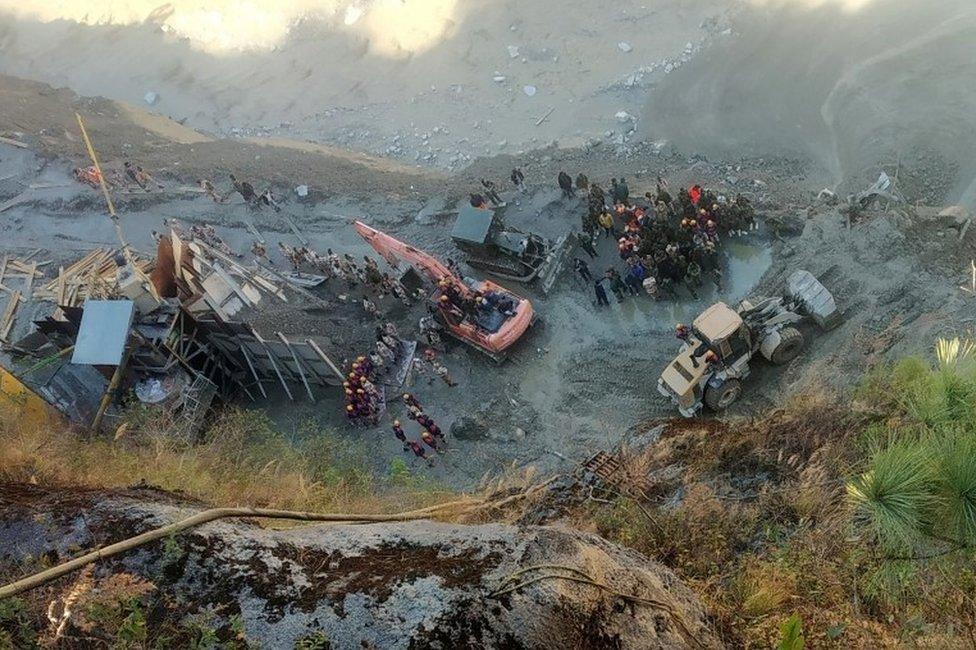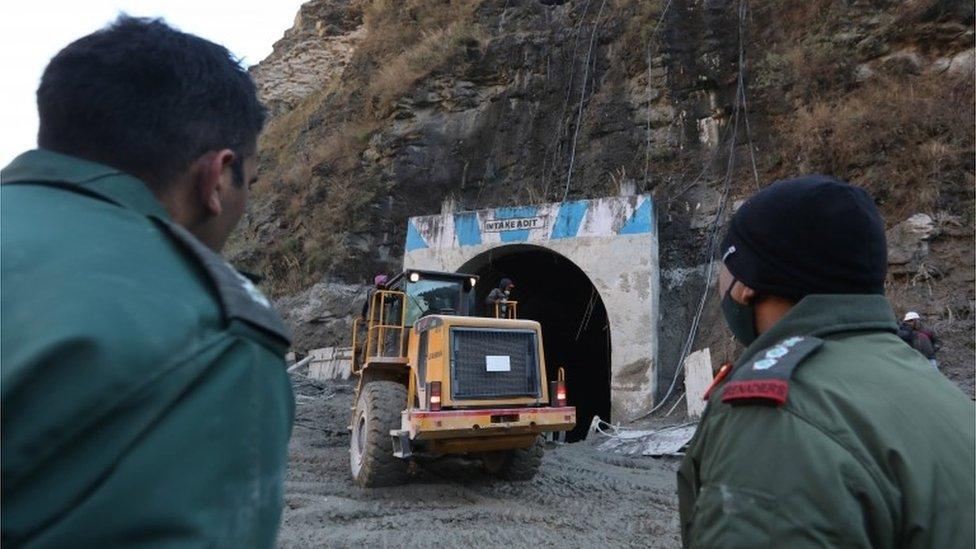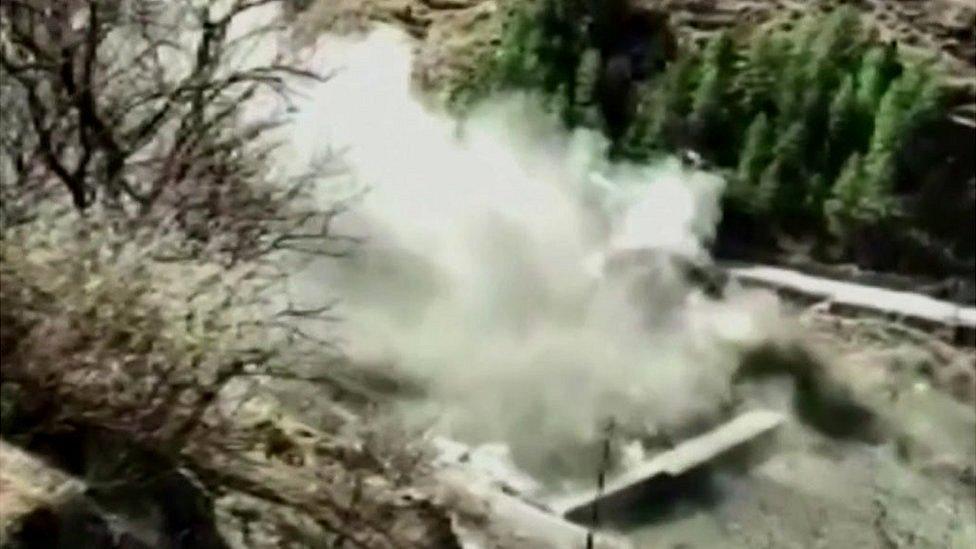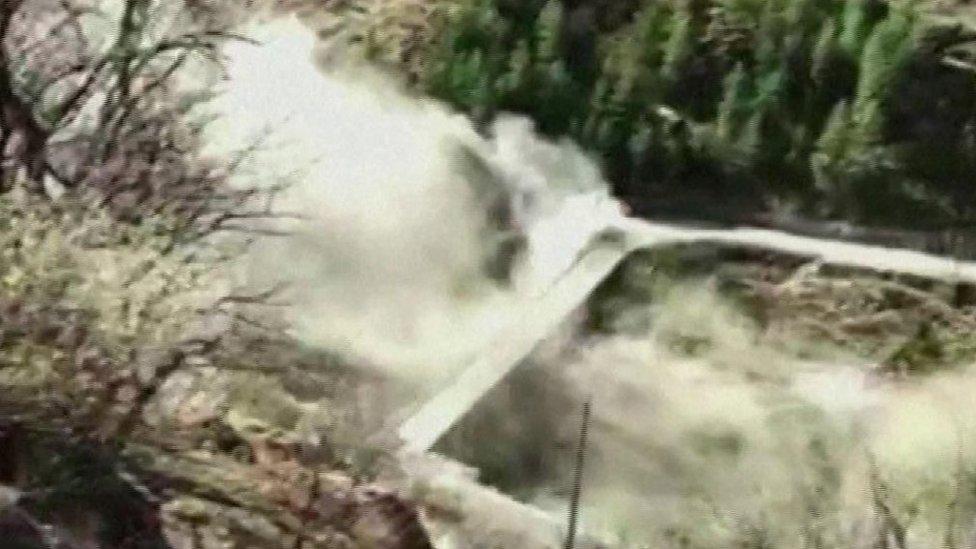Uttarakhand dam disaster: Race to rescue 150 people missing in India
- Published

Rescue workers are trying to clear a blocked tunnel in Uttarakhand
Emergency workers are searching for as many as 150 people after a piece of a Himalayan glacier is believed to have fallen into a river, triggering a huge flood in northern India and killing 26.
The floodwaters burst open a dam and a deluge of water poured through a valley in the state of Uttarakhand on Sunday.
Most of the missing are believed to be workers from two hydropower plants.
The rescue effort is focused on several sites, including a tunnel more than 200 metres (656ft) long.
More than 30 people were apparently trapped inside when the torrent of icy water swept down the valley, carrying rocks and earth as it gathered speed.
According to India's NDTV broadcaster, the tunnel is blocked with slush and debris., external
There has been no contact with the workers since Sunday, and officials say it is hard to tell where in the tunnel they are and whether they are together.
Hundreds of troops, paramilitaries and military helicopters have been sent to the region to help with rescue efforts.
Rescue workers and locals have been using shovels and mechanical diggers to try and clear the entrance to the tunnel.
NDTV reported that rescuers had also been seen with wooden planks to help them wade through the mud.
An investigation is continuing into what caused the suspected glacial burst.
The deluge washed away hydro and bridge infrastructure
Speaking from hospital, one man described the moment the tunnel flooded.
"We heard screams, 'get out, get out'. We didn't know what was happening. We started running to escape when the force of the water gushed in through the mouth of the tunnel. We couldn't get out because of that," he said.
"We held on to the [roof] of the tunnel. We held on for about an hour. As the water receded, we slowly climbed onto the big rocks that flowed in, to take a breath. We had lost hope. We didn't think we would survive."
Uttarakhand police said an avalanche struck at about 11:00 local time (05:30 GMT) on Sunday, destroying a dam known as the Rishiganga Hydroelectric Project.
Police said the impact catapulted water along the Dhauliganga river, damaging another power project downstream in the Tapovan area.
Senior police officials said a bridge in the Tapovan area that connected 13 villages was washed away in the avalanche. Food packets were air dropped in some of these villages.


One witness compared the flash flood with "a scene from a Bollywood film".
Video showed the floodwater barrelling through the area, leaving destruction in its wake.
Watch the moment a man trapped inside the tunnel is rescued
Emergency workers had earlier evacuated dozens of villages, but authorities later said the main flood danger had passed.
Emergency crews rescued 16 workers who had been trapped inside a tunnel filled with debris.
Officials told the BBC that between 35 and 40 others were thought to be trapped in a second tunnel.
Emergency crews have reached the mouth of the 2.5km (1.5 mile) tunnel and are in the process of clearing the area with heavy equipment.
Allow X content?
This article contains content provided by X. We ask for your permission before anything is loaded, as they may be using cookies and other technologies. You may want to read X’s cookie policy, external and privacy policy, external before accepting. To view this content choose ‘accept and continue’.
"We are trying to break open the tunnel," said Ashok Kumar, the state police chief, told the Reuters news agency. Rescuers had gone 150m inside, he added.
The director general of the National Disaster Response Force told ANI news agency that rescue operations could take up to 48 hours.

Officials fear that as many as 35-40 people may be trapped in the tunnel
Uttarakhand, in the western Himalayas, is prone to flash floods and landslides.
Some 6,000 people are believed to have been killed in floods in June 2013 which were triggered by the heaviest monsoon rains in decades.

What caused the flood?
Navin Singh Khadka, BBC World Service environment correspondent
The remoteness of where this happened means no-one has a definitive answer, so far.
Experts say one possibility is that massive ice blocks broke off the glacier due to a temperature rise, releasing a huge amount of water.
That could have caused avalanches bringing down rocks and mud.
"This is a strong possibility because there was a huge amount of sediment flowing down," said DP Dobhal, a senior glaciologist formerly with the government's Wadia Institute of Himalayan Geology.
Experts say an avalanche could also have hit a glacial lake that then burst.
Another possibility is that an avalanche or landslide may have dammed the river for some time, causing it to burst out after the water level rose.

Sunday's disaster has prompted calls by environment groups to review power projects in the ecologically sensitive mountains.
"Avalanches are common phenomena in the catchment area," MPS Bisht, director of the Uttarakhand Space Application Centre, told AFP news agency.
"Huge landslides also frequently occur."
Uma Bharti, a former water resources minister, said she had spoken out against power projects on the Ganges and its tributaries.
- Published7 February 2021

- Published7 February 2021

- Published7 February 2021
